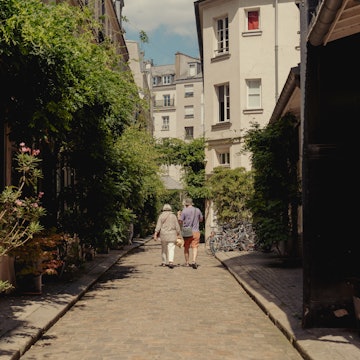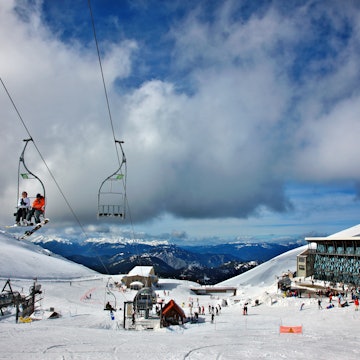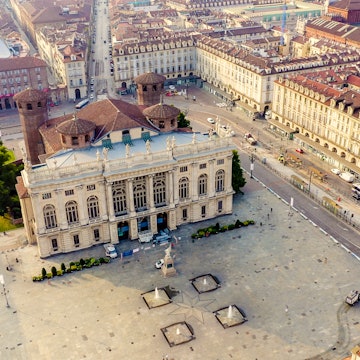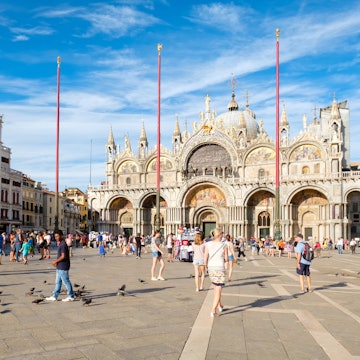

Pienza is one of Italy's most beautiful villages, renowned for its slow pace of life. John Silver/Shutterstock
No country does hill towns quite like Italy. Swing through poppy fields, olive groves and vineyards, and suddenly you’ll alight upon an eyrie-like medieval village in ochre stone that will make your heart sing.
From the snow-frosted mountains of the north to the sparkling coastlines of the south, Italy’s small towns and villages are madly romantic. Whether it’s fresh truffle pasta on a piazza where an out-of-tune campanile tolls, a passeggiata (stroll) on a grand Renaissance square, or a dip in the sea before a sunset aperitivo surrounded by ancient Roman walls, this country delivers time and again.
We’ve combed Italy from the top of its elegant boot to its slender heel to track down the country’s most enticing villages and towns, which impress with their looks and endear with their spirit.
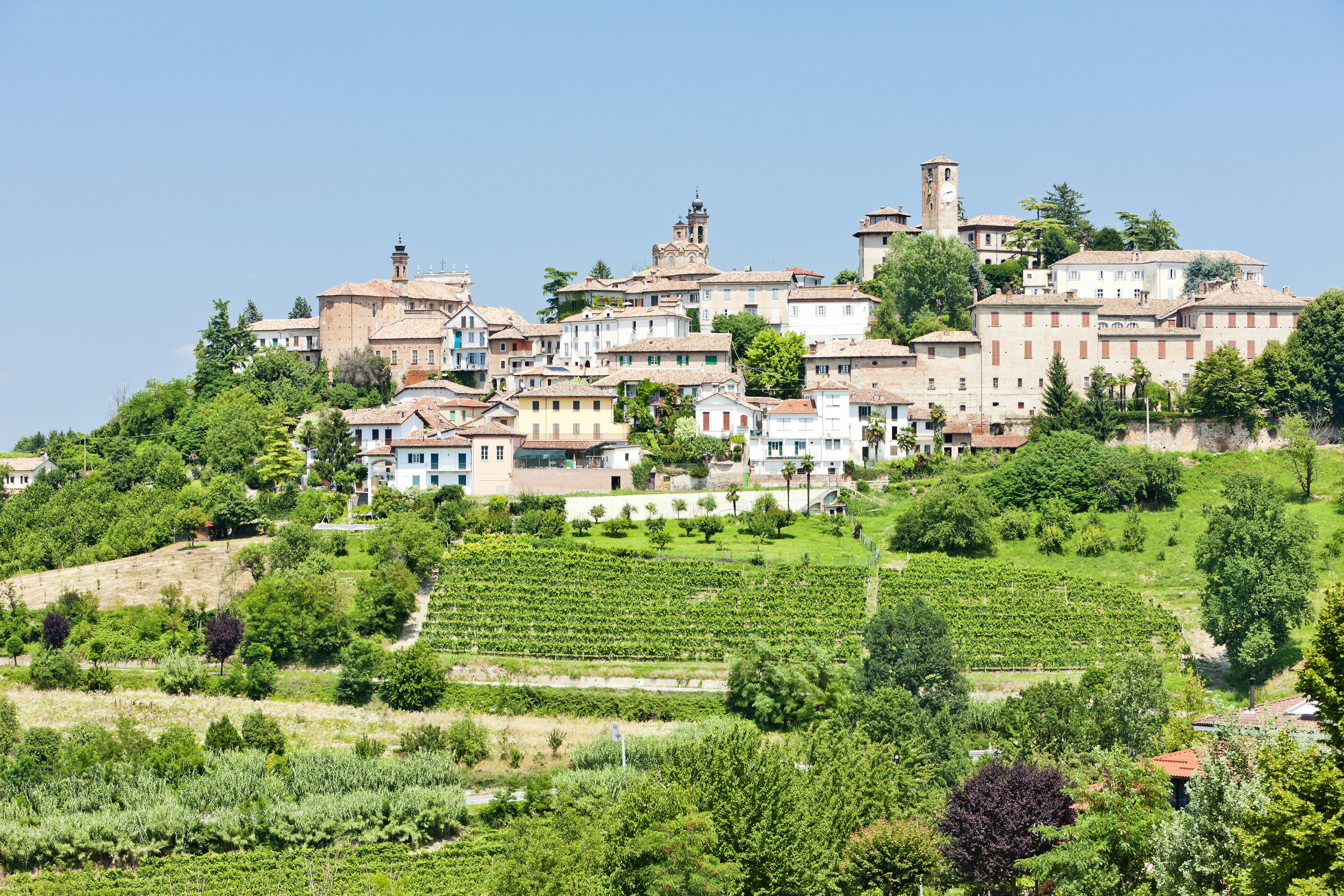
1. Neive, Piedmont
Best for wine tasting and vineyard strolls
Medieval stone walls as warm as the setting sun? Check. Hilltop location and views so idyllic you’ll be googling the price of local houses pronto? Check. Vine-ribbed slopes producing some of the region’s most stunning wines? Check. What Neive in Piedmont lacks in obvious tourist appeal, it more than makes up for in classic Italian looks and charisma, earning it a ranking as one of Italy's borghi più belli (most beautiful towns).
Days unfold at a blissfully slow pace, with rambles through historic alleyways, sunny piazzas and vineyards. The town is known for its four signature vini (wines) – Dolcetto d'Alba, Barbaresco, Moscato and Barbera d'Alba. Give them a whirl with a cellar tour and tasting at La Cassetta del Castello, an enoteca (wine bar) enclosed within medieval castle walls, or go for an alfresco aperitivo at Al Nido Della Cinciallegra.
Planning tip: All that sipping and swirling works up an appetite for lunch. Stop at an old-school osteria like Borgo Vecchio, where home-cooking has a pinch of love – from fresh pasta to minestrone de la nonna (grandma’s vegetable soup) and torta di nocciole (hazelnut cake).
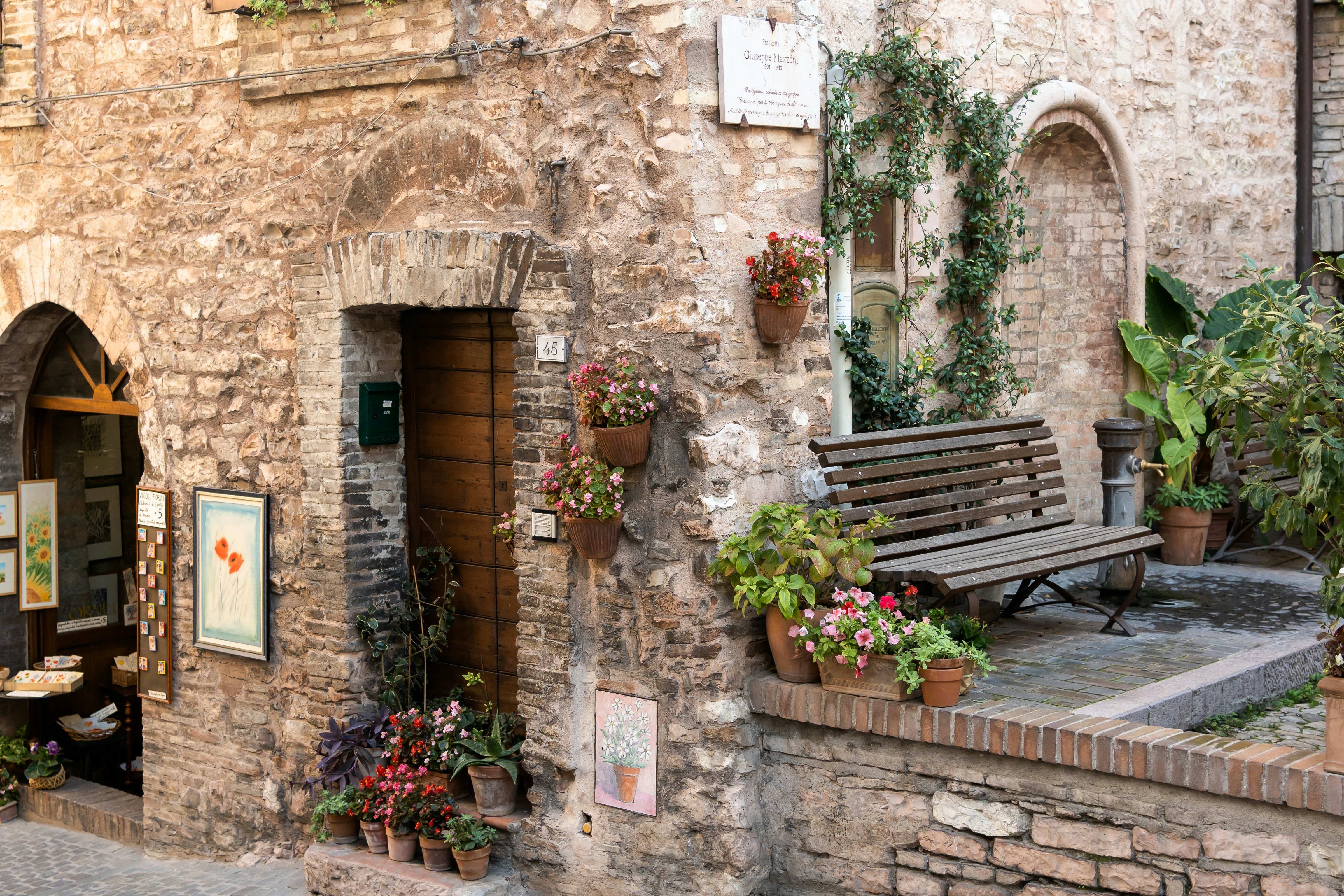
2. Spello, Umbria
Best for picture-book medieval looks
A vision in warm honey stone cascading down a hillside in Umbria’s lushly green and rugged heart, Spello is instant love. Neighboring Tuscany gets all the fuss, but you’d be hard-pressed to find a prettier Italian village. Ringed by ancient Roman walls and towers, Spello’s centro storico (historic centre) is an atmospheric tangle of cobbled lanes, Gothic churches and flower-filled alleys.
You wouldn’t expect to find big-hitter sights in such a dinky village, so prepare to be surprised by the Renaissance frescoes and Pinturicchio masterpieces gracing the Chiesa di Sant'Andrea and the 12th-century Chiesa di Santa Maria Maggiore. Also, seek out the exquisitely preserved mosaics unearthed in a Roman villa on show at Villa dei Mosaici.
Mostly, though, the true joy of Spello is clicking into its laid-back rhythm: pinning down a family-run trattoria to try local olive oils, salume and black truffles, or sipping a glass of local wine at Enoteca Properzio. To properly slow the pace, head to Agriturismo Il Bastione, hidden among the olive groves on the fringes of the village, for soul-stirring views and feasts of home-grown produce.
Planning tip: Want to see Spello at its blooming best? Time your visit for the Infiorate di Spello on Corpus Domini in June, when the village goes all out with intricate carpets of flowers patterning the streets – a riot of color and scent.

3. Atrani, Campania
Best for low-key Amalfi style
Blink and you’ll miss what is officially Italy’s tiniest village, Atrani, with a surface area of just 0.12 sq km - and what a shame that would be. On Italy’s ritzy, absurdly beautiful Amalfi Coast, UNESCO World Heritage Atrani is a little bubble of medieval beauty. Lofty mountains pucker up on the horizon, the Tyrrhenian Sea spreads out like a sapphire-blue silk sheet, and the centro storico is pinch-yourself pretty, with its higgledy-piggledy assortment of whitewashed alleys, arches, courtyards, pastel-hued houses and scalinatelle (stairways). By night, fishermen’s lamps flicker across the sea like fireflies.
Romantic? You bet, but don’t expect to have it all to yourself – since the village popped up in the Netflix series Ripley, starring Andrew Scott, more visitors are flocking here than ever. But come during the quieter spring and autumn months, and the dream is still real.
Planning tip: Atrani makes a great low-key base for striking out along the Amalfi Coast – Amalfi, with its sunny piazzas, beach and neo-Moorish cathedral, is just a 10-minute walk around the headland, while Ravello is a 10-minute drive away.

4. Sperlonga, Lazio
Best for dreamy sea views
When the late-afternoon sun beats down on white, bougainvillea-draped walls, casting long shadows across the narrow alleyways and steep steps in Sperlonga’s medina-like centre, you feel as though you’ve stepped onto a film set. Hugging a rocky promontory above a long curve of golden beach lapped by the turquoise Tyrrhenian Sea, Sperlonga is a beauty. Yet, miraculously, the coastal stunner has somehow sidestepped the tourist spotlight. Whisper quietly about it, whatever you do.
Once you’ve roamed the medieval center and paused for coffee at Piazza della Libertà, head to Villa di Tiberio, Sperlonga’s archaeological museum. Here, glimpse ancient sculptures and explore the ruins of Emperor Tiberius' waterfront villa, set around a sea grotto. Back in town, book a table at Altrò for a feast of boat-fresh clams, mussels and prawns that are a true hit of the sea.
Planning tip: Sperlonga is midway between Rome and Naples (both are about a two-hour drive), making it ideal for combining a culture-loaded city break with a stint by the sea.

5. Cefalù, Sicily
Best for Arab-Norman architecture
If ever a town is going to make you fall head over heels in love with Italy, it will be ravishing Cefalù on Sicily’s wave-pummelled north coast. Topped off by La Rocca, a massive plug of rock encrusted with the ruins of an Arab-Norman castle, Il Castello, Cefalù is a heart-stealer with its honey-hued stone houses, jumble of cobbled alleys and medieval piazzas, and cathedral lavishly gilded with 12th-century Byzantine mosaics. The clincher is the beach: a great sweep of blond sand easing into the surf of the Tyrrhenian Sea.
Seen in the pastels of sunrise and sunset, the light here has a dream-like quality, which made it perfect for filming scenes in Giuseppe Tornatore’s 1988 film Cinema Paradiso. For silver screen-worthy views, clamber up to the 17th-century Bastione di Capo Marchiafava or hoof it beyond the city walls to the summit of La Rocca on the steeply climbing Salita Saraceni.
Planning tip: Cefalù’s loveliness is no secret, so it’s well-worth dodging peak summer season for a more peaceful experience and more affordable room rates. Try spring or early autumn instead.

6. Alberobello, Puglia
Best for fairytale trulli
Nothing screams Puglia like white-washed, conical-roofed trulli (dry-stone huts) emerging from the sun-scorched, olive tree-brushed plains of the Valle d’Itria like some kind of Flintstones-inspired fantasy. Some of the finest trulli sprinkle the cobbled lanes of UNESCO World Heritage Alberobello at the top of Italy’s heel. The pint-sized town will make you draw breath with hundreds of 15th-century, beehive-shaped houses made from local limestone dotting its two hills – Rione Monti and Rione Aia Piccola.
Alberobello is the kind of town that hoovers up Instagram likes, however, so if you come in summer, you might not be able to see the true beauty of the trulli (many of which are now souvenir shops) for the maddening crowds. Visit in spring or summer for more peace and stay overnight to experience Alberobello when the day-trippers have departed. Trullidea rents out quaint, cozy self-catering properties and B&B trulli in the historic center.
Planning tip: Don’t rush straight off. There are more gorgeous places to discover nearby, with top billing going to Ostuni. The neighboring town glitters white in the sun, with striking medieval architecture, a magnificent Gothic-Romanesque cathedral and arresting views across the Adriatic Sea.

7. Ascoli Piceno, Le Marche
Best for glorious food
As blue dusk falls over Ascoli Piceno’s Piazza del Popolo – a pale and graceful beauty in travertine marble - you might wonder why you’ve rarely heard of this town in Italy’s under-the-radar Le Marche region. As locals head out on their evening passeggiata, ducking in and out of Renaissance arcades and pausing piazza-side for an aperitivo, the happy burble of chatter rises from bars and cafes, as medieval churches and palazzi glow gold.
Tourists don’t seem to have quite gotten the memo about Ascoli – and that makes it all the more special when you get the chance to pound its medieval streets and gawp at Titian masterpieces hiding in the 17th-century Palazzo Comunale’s Pinacoteca. And the food is sensational - try olive all'ascolana (meat-stuffed fried olives) and cacciannaz (focaccia served with mortadella). The icing on the cake is sleeping in style at 16th-century Palazzo dei Mercanti for the price a simple B&B would cost you elsewhere.
Planning tip: Forget Siena’s over-crowded Palio. A terrific, less-touristy alternative is Ascoli Piceno’s La Quintana in August, with knights in armor, flag-throwers, parades, jousting and thousands of locals in medieval garb.

8. Pienza, Tuscany
Best for Renaissance flair
Tick off pretty medieval hill towns like rosary beads in Tuscany as you weave among the poppy-flecked meadows and cypress-studded heights. There are more famous towns, but one of the loveliest is Pienza in the UNESCO-stamped Val d’Orcia, a region shaped by chalk plains and conical hills crested by fortified settlements. A man of grand designs, Pope Pius II set about transforming his home village into a resplendent Renaissance town in 1459. Its looks have little changed in more than 500 years.
Go for a wander and you’ll be spellbound by the Duomo, a pale travertine marble beauty, which rises above the Piazza Pio II, the town’s showpiece Renaissance square. Just steps away is Sette di Vino, an endearingly old-school osteria, where you can dig into local faves like zuppa di pane e fagioli (bread and white-bean soup). There’s just a handful of tables, so book ahead.
Planning tip: Pienza can get busy on weekends (especially in peak summer), so visit midweek to see it at its quiet best.
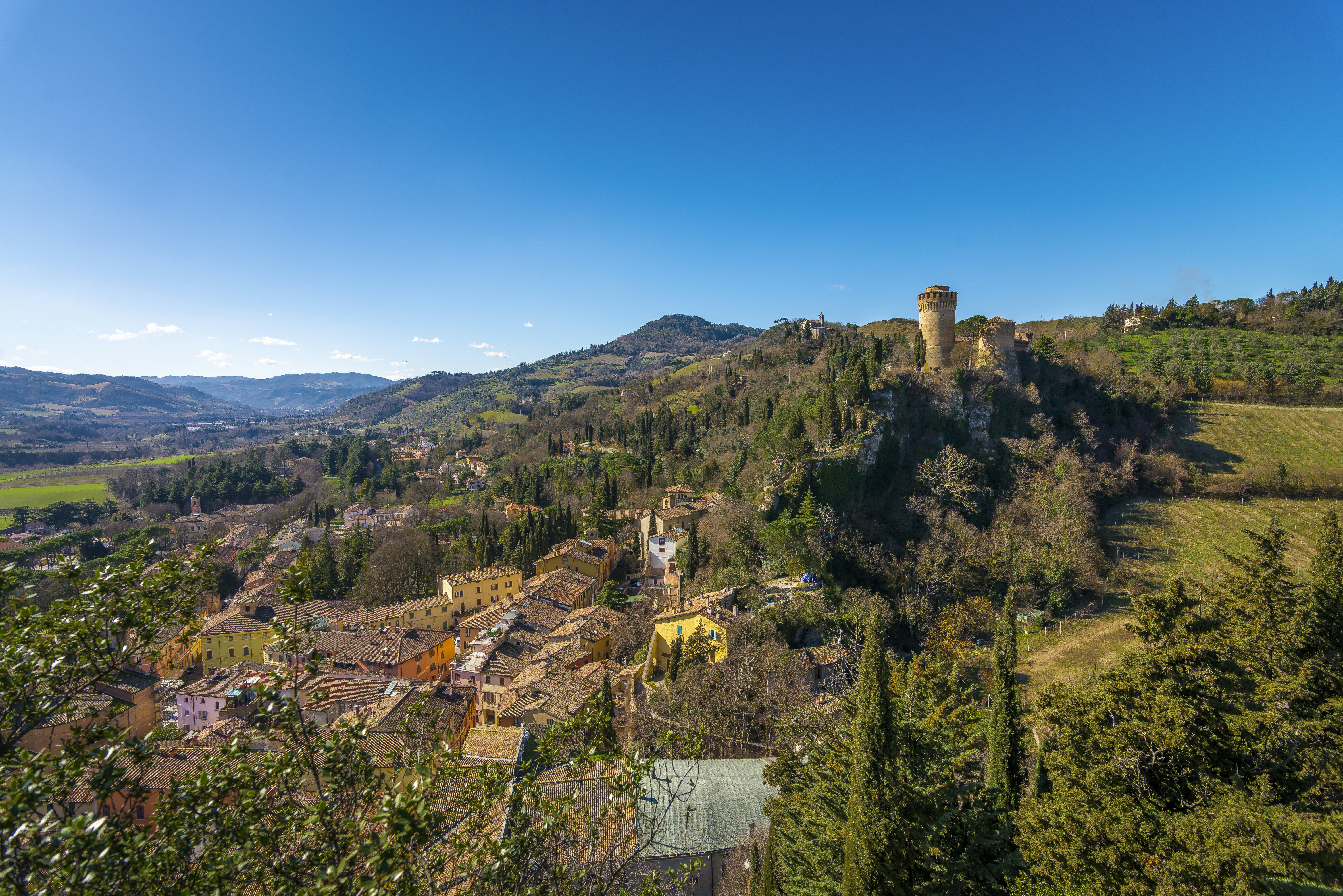
9. Brisighella, Emilia-Romagna
Best for castles and climbs
Cinematically plonked atop a wooded hillside surrounded by olive groves and at the foot of the Apennines, the medieval town of Brisighella in Emilia-Romagna is a picture, with its mosaic of terracotta rooftops, shuttered townhouses in a fresco painter’s palette of pastels, and stirring views over hills ribboned with vineyards and olive groves. For a view, climb up to one of its hilltop lookouts: La Rocca (The Rock) fortress, Torre dell'Orologio (The Clocktower) and Il Monticino.
Back in the centro storico, rewind time with a stroll along the Via degli Asini, a wonky, wood-beamed covered walkway that dates to 1290. These cobbles have been worn smooth over the centuries by shoe leather and – as the name suggests – cart-pulling donkeys, who once lugged gypsum from nearby quarries.
If you like food with a shot of history, L'osteria di Guercinoro is heaven. Lodged in a stone-vaulted grotto from the 1300s, the restaurant whips up season-spun flavors – tagliatelle with rare-breed Tuscan pig ragout, lasagne with wild asparagus, broad beans with pecorino, regional salume – all delicious, especially when washed down with local wines.
Planning tip: Visit between mid-April and mid-May to eat the freshest Moretto artichokes, a small, thorny and tasty variety only grown in the Valle del Lamone.

10. San Pantaleo, Sardinia
Best for escaping coastal crowds
When the setting sun casts the valleys into shadow and makes the surrounding granite peaks blush pink, the tiny village of San Pantaleo in the wild, boulder-strewn interior of northern Sardinia’s Gallura region, never looks prettier. Though just a stone-skim away from the island’s glitzy, celeb-magnet Costa Smeralda, this cute-as-a-button mountain village wings you back in time with its bougainvillea-draped streets and Romanesque-Pisan church.
There’s not much to do here apart from take a breather from the coast – and that’s a good thing. Come to roam around local artisan galleries and craft shops, or kick back piazza-side with a coffee or glass of Vermentino white wine at Caffè Nina. Food-wise, the village has a treasure up its sleeve: Michelin-starred Il Fuoco Sacro in the gorgeously rustic Pedra Secreta resort, where chefs riff imaginatively on farm-fresh island produce.
Planning tip: Book brunch, an aperitivo or tour and tasting at the state-of-the-art Surrau winery nearby. The vines produce some of Gallura’s finest Vermentino whites and Cannonau reds.

11. Sappada, Dolomites
Best for embracing the mountains
Jagged peaks tear across the horizon in Sappada, right in the dramatic heart of the Dolomites in Italy's northeastern Friuli-Venezia Giulia region, but a yodel away from the Austrian border. With its authentic mountain flavor and rugged good looks, this alluring village perfectly nails the Alpine fantasy – and is often voted one of the country’s prettiest.
If you’re a fan of rustic Nordic-style mountain architecture, you’ll be in your element exploring the village’s blockbau houses, 17th and 18th-century stone-and-timber chalets with overlapping beams, hay-lofts and window boxes that brim with fiery red geraniums in summer. Spot them in Sappada Vecchia and Cima Sappada, the oldest areas of the village.
Besides this, Sappada’s appeal is its outdoors. Come to hike and bike for miles on trails weaving into the mountains, returning at sundown to pin down a restaurant where you can dig into canederli (Tyrolean bread dumplings), local game and mushrooms.
Planning tip: Time your visit for the Sappamukki festival in late September when flower-wreathed cows descend from their high summer pastures and the village leaps to life with food, music and merrymaking.

12. Bellagio, Lake Como
Best for lakeside dolce vita
On the shores of true-blue, mountain-rimmed Lake Como, Bellagio looks a million dollars. The fetching little town often makes first-time visitors gasp out loud when they clap eyes on its steep cobbled streets that curl ever higher past pastel-painted, terracotta-roofed, shuttered houses, flowery gardens and cypress groves, with snapshots of the glittering waterfront far below. It’s like something freshly minted for an Italian romcom.
Once you’ve romped around the centro storico and ticked off the Romanesque church, immerse yourself in the statue-strewn gardens of neoclassical Villa Melzi d’Eril, which are awash with azaleas and rhododendrons in spring. Or follow in Queen Victoria’s dainty, satin-shoed footsteps to the terraced park and gardens at equally grand Villa Serbelloni. A sunset boat tour around the headland is a crazily romantic way to wind out the day.
Planning tip: Bellagio’s beauty is no secret, and the town gets swamped with tourists and day-trippers in peak summer. Visit in the shoulder seasons or midweek for a quieter feel.








